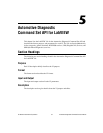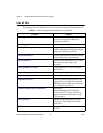
Chapter 4 Using the Automotive Diagnostic Command Set
Automotive Diagnostic Command Set User Manual 4-4 ni.com
When you finish your diagnostic services, you must close the diagnostic
communication link. This finally closes the CAN port. For the VW TP 2.0,
you should disconnect the communication channel established before
closing.
Available Diagnostic Services
The standards on automotive diagnostic define many different services for
many purposes. Unfortunately, most services leave a large amount of room
for manufacturer-specific variants and extensions. National Instruments
implemented the most used variants while trying not to overload them with
optional parameters.
However, all services are implemented in LabVIEW and open to the user.
If you are missing a service or variant of an existing service, you can easily
add or modify it on your own.
In the C API, you can also implement your own diagnostic services using
the ndDiagnosticService routine. However, the templates from the existing
services are not available.
Tweaking the Transport Protocol
A set of global constants controls transport protocol behavior. These
constants default to maximum performance. To check the properties of an
implementation of a transport protocol in an ECU, for example, you may
want to change the constants to nonstandard values using the Get/Set
Property routines.
The transport protocols also are fully implemented in LabVIEW and open
to the user. In LabVIEW, you can even modify the protocol behavior (for
example, you can send undefined responses to check the behavior of an
implementation).
However, be sure to save the original routine versions to restore the original
behavior.
In the C API, changing the global constants is the only way to modify the
transport protocol.


















